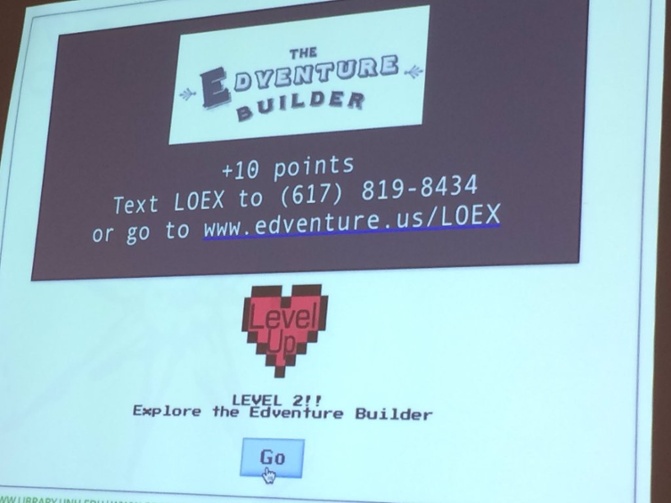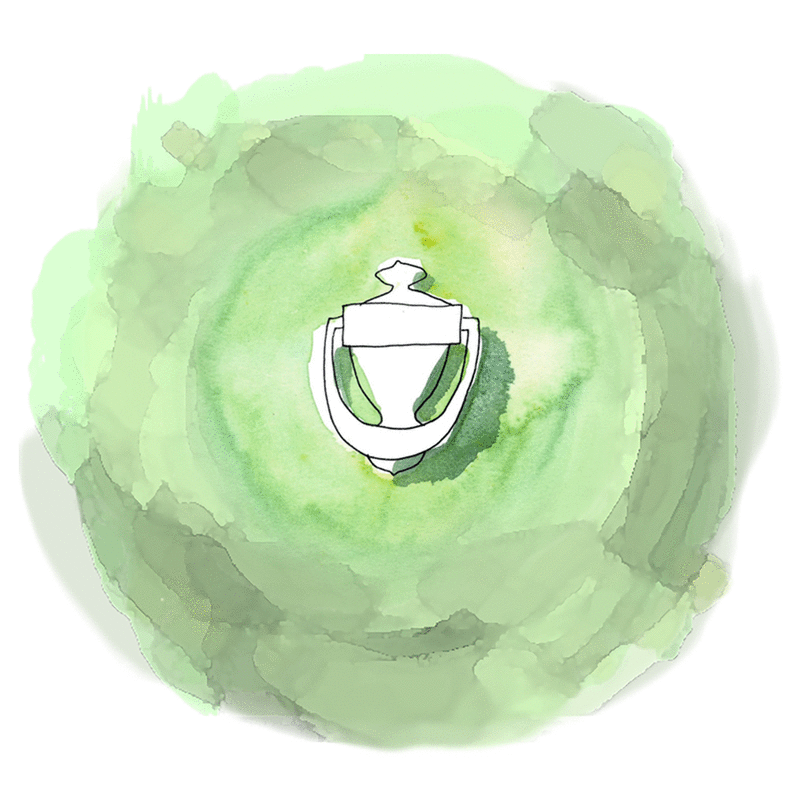To university libraries and beyond!!!! LOEX2016 was a fantastic conference with lots of ideas on how to make library instruction more interactive and YES, even game-based! Three in particular stood out for me, so here’s an overview of how three different university libraries used three different methods and got different- but all successful- results.
1. ACTIVE LEARNING THROUGH ACTIVE SPACES FROM MATTHEW PICKENS
(MISSOURI UNIVERSITY OF SCIENCE & TECHNOLOGY)
The Missouri University of Science and Technology has 1600 undergrads with 1 library, 9 librarians and 13 non-librarian staff. Their challenge is a pre-freshman orientation that gets a few hundred kids. Typically, the library staff would do the regular classroom instruction followed by a tour but Matthew got some inspiration from a local haunted house.
What would happen- he thought- if the library instruction had MULTIPLE TABLEAUX, like a haunted house? This may sound like a funny correlation but in fact a lot of immersive theater organizations are turning to haunted houses as a model of loosely guiding while still letting people be independent and immersed in an environment. This works especially well when you have a few different genres of information to explain and that’s what Matthew did: they had the 4 groups that went through 4 different rooms of library information for 10 minutes each.
As you can see in this hand-out, Matthew’s way of getting people through 4 rooms in 50 minutes was to scheduled it down to the very last minute. It’s an interesting approach but when you’re working with a team who’s not used to this kind of engagement, it helps people to feel more comfortable. Fear not! Everything is “under control”. Of course, like always, everything changed in unexpected and uncontrollable ways: students showed up late and then had to do paperwork knocking 15 mins off a tour that was scheduled down to the last second.
Luckily Matthew’s team was wise enough to see the schedule and then break it according to how their players actually responded. They were flexible and they pulled it off without a snag- and I suspect, came out of it with a lot more confidence that they could build something immersive and non-standard in the future!
The good part- it worked!! And the students loved it. The not as good part, it seems like it was a pretty staff-intensive game. I loved how they used the “haunted house” idea and were willing to go for it even though it was a new approach for his team. Not only that, when everything went wrong (as they inevitably do), they rolled with the punches and delivered a great, engaging program!
2. REDUCE, REUSE, UPCYCLE: TURNING INTERACTIVE INSTRUCTION INTO GAME-BASED CAMOGOGY
BETHANY TSCHAEPE, JOVANNI LOTA AND MEGAN HOPWOOD (UNIVERSITY OF HOUSTON-DOWNTOWN)
Next in line, the library team from the University of Houston, Downton introduced me to a new term: “Camogogy”. This, I love… it’s the idea of pedagogy that’s disguised in a way that it doesn’t scream “LEARNING!!”. It’s so much better than “gamification”. (If you feel like reading a Kellian rant, you’re welcome to check out my blog post on the term “Gamification”.)
But I digress- this talk was about a fantastic “Clue-based” mystery in the UHD library. As you probably all know, I’ve had a soft spot for Clue since we worked with the Metropolitan Museum of Art on Murder at the Met but this one had a fun twist: augmented reality!
The University of Houston Downton has an entirely off-campus student body so they have an unusual challenge for their library orientation- how do they get people to explore the library on their own time, and not as part of a tour? They came up with a great solution in Aurasma, a free, easy-to-use augmented reality app that lets you use your camera phone to take a look at an image and get content.
They called this awesome session “Reduce, Reuse and Upcycle” because they used their existing Aurasma tour and
added a murder mystery story to it, “A Murder Most Foul”, which cut their production time probably in half. One of the speakers was a you-tuber (I think that’s a word) and the quality of the videos they made was really great, I’m sad I can’t find any of them to share. They released the game as a way to explore the library, solve a mystery and use real library skills to get there. They released it on Halloween and had 36 players who really seemed to enjoy it.
They assessed people’s learning through the game by seeing how far along the game players got and if they were able to uncover the information, which could only be gotten by finding specific books and articles in the library.
This was a lot of work for 36 players so it may be hard to scale, but as they reminded us, this project was recycled so they used content from an existing immersive tour they already had in their library. A great example of how once you build it, your immersive/interactive content can grow to become all sorts of new things!
It was also really inspiring to see how a team who was excited about their work could produce something so cool with a relatively small budget. They also did some great research on examples of other university libraries that are building games and murder mysteries. I’ve never seen a list like this before so I thought that was pretty exciting, made me wonder if we should build a LibGames Wiki like the Museum Games Wiki.
3.HELPING OUTLIERS BECOME COLLEGE READY: USING TECHNOLOGY TO CULTIVATE POSITIVE RELATIONSHIPS WITH STUDENTS ENROLLED IN REMEDIAL CURRICULUM
SAVANNAH KELLY (UNIVERSITY OF MISSISSIPPI)
Last but not least was a really Important conversation about students in remediation classes and how libraries can help them. I was surprised to see games, technology and interactivity as a solution for how to “cultivate positive relationships” with students who are in classes that they don’t want to be in but once I was there I realized OF COURSE it involves games! Games, fun activities and interactive content are an extremely successful way to engage students- and that’s even more important for students who wish they were in another class.
This game was built for students in remediation classes at the University of Mississippi Library. Ole Miss has 25K students and an open admission policy for all Mississippi residents, which means there’s often an information and skills gap for incoming freshmen. The speaker, Savannah Kelly said that remediation library literacy involved up to 80 “one shots” (50-minute one-time library literacy classes for the non-librarians among us.) Savannah built simple but effective game-based tour and involved a phone and what she called an “Elmo projector”. I expected this to be a red and fuzzy projector but in fact it was a camera projector, one that will project on the wall whatever object you put on its surface. She built a series of quick but really great questions for students to findtheir own answers to around thelibrary. Students show up for their obligatory “one shot” class and instead of a lecture on how to use the library, they run around as a group with a camera and take pictures of their answers to open questions like these
The questions were purposely open, which meant that students couldn’t get things “wrong” and were truly free to explore. It also meant that the librarians get interesting data on how students respond to these questions. When they finish taking their pictures after 20 minutes, students come back to the classroom to discuss what they found and share their photos. (Because who doesn’t like sharing photos.) This alsogives you a great opportunity to have a real class discussion about things and students have reference points to the things you’re talking about.
Students seemed to really respond to this method and 82% admitted enjoying the session. The activity was simple and direct but was also interactive, could scale easily and is not difficult to administer or play. (Remember rule #1: people should not spend longer learning to play your game than they spend playing it.)
Though all of these games were fantastic, the ease, scalability and relative success of this one really struck me as something that achieved its goal simply, could be applied more broadly to the library curriculum and couldl have some longevity. Often when people want to build interactives, they get very ambitious but for your first project, usually what you want is what we call in the startup world an MVP- a minimum viable product: how cheaply, easily, simply and non-dramatically can we get a stable product to “market”? (Or in this case- used by students.) Start with a simple and robust plan and then scale it from there!
CONCLUSION:
And of course there was a fourth presentation about using games for library instruction, our fabulous presentation, Playing with FIRE: Gamifying Library Instruction in a First-Year Experience Program, which I presented with Kathrine Aydelott of the University of NH library.
I don’t want to give you any spoiler alerts, but let’s just say we made it a choose-your-own adventure presentation and it involved some pretty fantastic cat-eye glasses from the Andy Warhol Museum. You can also check out a mobile version via the Edventure Builder by going to the link below!


Leave a Reply